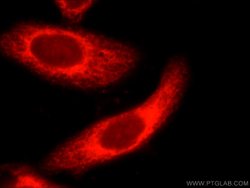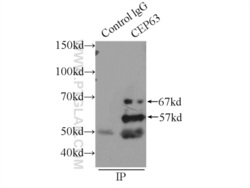Antibody data
- Antibody Data
- Antigen structure
- References [15]
- Comments [0]
- Validations
- Western blot [1]
- Immunocytochemistry [1]
- Immunoprecipitation [1]
Submit
Validation data
Reference
Comment
Report error
- Product number
- 16268-1-AP - Provider product page

- Provider
- Proteintech Group
- Proper citation
- Proteintech Cat#16268-1-AP, RRID:AB_2077079
- Product name
- CEP63 antibody
- Antibody type
- Polyclonal
- Description
- KD/KO validated CEP63 antibody (Cat. #16268-1-AP) is a rabbit polyclonal antibody that shows reactivity with human, mouse, rat, Canine and has been validated for the following applications: IF, IHC, IP, WB,ELISA.
- Reactivity
- Human, Mouse, Rat, Canine
- Host
- Rabbit
- Conjugate
- Unconjugated
- Isotype
- IgG
- Vial size
- 20ul, 150ul
Submitted references Molecular basis promoting centriole triplet microtubule assembly.
Time-series reconstruction of the molecular architecture of human centriole assembly.
Zika virus alters centrosome organization to suppress the innate immune response.
CCHCR1-astrin interaction promotes centriole duplication through recruitment of CEP72.
The mechanism of acentrosomal spindle assembly in human oocytes.
Cep57 and Cep57L1 maintain centriole engagement in interphase to ensure centriole duplication cycle.
Selective autophagy maintains centrosome integrity and accurate mitosis by turnover of centriolar satellites.
Massive centriole production can occur in the absence of deuterosomes in multiciliated cells.
Cytoplasmic E2f4 forms organizing centres for initiation of centriole amplification during multiciliogenesis.
Microcephaly Proteins Wdr62 and Aspm Define a Mother Centriole Complex Regulating Centriole Biogenesis, Apical Complex, and Cell Fate.
Autophagy controls centrosome number by degrading Cep63.
Truncating mutation in the autophagy gene UVRAG confers oncogenic properties and chemosensitivity in colorectal cancers.
Centriolar satellites assemble centrosomal microcephaly proteins to recruit CDK2 and promote centriole duplication.
Cep63 and cep152 cooperate to ensure centriole duplication.
A dual role for UVRAG in maintaining chromosomal stability independent of autophagy.
Takeda Y, Chinen T, Honda S, Takatori S, Okuda S, Yamamoto S, Fukuyama M, Takeuchi K, Tomita T, Hata S, Kitagawa D
Nature communications 2024 Mar 22;15(1):2216
Nature communications 2024 Mar 22;15(1):2216
Time-series reconstruction of the molecular architecture of human centriole assembly.
Laporte MH, Gambarotto D, Bertiaux É, Bournonville L, Louvel V, Nunes JM, Borgers S, Hamel V, Guichard P
Cell 2024 Apr 25;187(9):2158-2174.e19
Cell 2024 Apr 25;187(9):2158-2174.e19
Zika virus alters centrosome organization to suppress the innate immune response.
Kodani A, Knopp KA, Di Lullo E, Retallack H, Kriegstein AR, DeRisi JL, Reiter JF
EMBO reports 2022 Sep 5;23(9):e52211
EMBO reports 2022 Sep 5;23(9):e52211
CCHCR1-astrin interaction promotes centriole duplication through recruitment of CEP72.
Ying Z, Wang K, Wu J, Wang M, Yang J, Wang X, Zhou G, Chen H, Xu H, Sze SCW, Gao F, Li C, Sha O
BMC biology 2022 Oct 24;20(1):240
BMC biology 2022 Oct 24;20(1):240
The mechanism of acentrosomal spindle assembly in human oocytes.
Wu T, Dong J, Fu J, Kuang Y, Chen B, Gu H, Luo Y, Gu R, Zhang M, Li W, Dong X, Sun X, Sang Q, Wang L
Science (New York, N.Y.) 2022 Nov 18;378(6621):eabq7361
Science (New York, N.Y.) 2022 Nov 18;378(6621):eabq7361
Cep57 and Cep57L1 maintain centriole engagement in interphase to ensure centriole duplication cycle.
Ito KK, Watanabe K, Ishida H, Matsuhashi K, Chinen T, Hata S, Kitagawa D
The Journal of cell biology 2021 Mar 1;220(3)
The Journal of cell biology 2021 Mar 1;220(3)
Selective autophagy maintains centrosome integrity and accurate mitosis by turnover of centriolar satellites.
Holdgaard SG, Cianfanelli V, Pupo E, Lambrughi M, Lubas M, Nielsen JC, Eibes S, Maiani E, Harder LM, Wesch N, Foged MM, Maeda K, Nazio F, de la Ballina LR, Dötsch V, Brech A, Frankel LB, Jäättelä M, Locatelli F, Barisic M, Andersen JS, Bekker-Jensen S, Lund AH, Rogov VV, Papaleo E, Lanzetti L, De Zio D, Cecconi F
Nature communications 2019 Sep 13;10(1):4176
Nature communications 2019 Sep 13;10(1):4176
Massive centriole production can occur in the absence of deuterosomes in multiciliated cells.
Mercey O, Levine MS, LoMastro GM, Rostaing P, Brotslaw E, Gomez V, Kumar A, Spassky N, Mitchell BJ, Meunier A, Holland AJ
Nature cell biology 2019 Dec;21(12):1544-1552
Nature cell biology 2019 Dec;21(12):1544-1552
Cytoplasmic E2f4 forms organizing centres for initiation of centriole amplification during multiciliogenesis.
Mori M, Hazan R, Danielian PS, Mahoney JE, Li H, Lu J, Miller ES, Zhu X, Lees JA, Cardoso WV
Nature communications 2017 Jul 4;8:15857
Nature communications 2017 Jul 4;8:15857
Microcephaly Proteins Wdr62 and Aspm Define a Mother Centriole Complex Regulating Centriole Biogenesis, Apical Complex, and Cell Fate.
Jayaraman D, Kodani A, Gonzalez DM, Mancias JD, Mochida GH, Vagnoni C, Johnson J, Krogan N, Harper JW, Reiter JF, Yu TW, Bae BI, Walsh CA
Neuron 2016 Nov 23;92(4):813-828
Neuron 2016 Nov 23;92(4):813-828
Autophagy controls centrosome number by degrading Cep63.
Watanabe Y, Honda S, Konishi A, Arakawa S, Murohashi M, Yamaguchi H, Torii S, Tanabe M, Tanaka S, Warabi E, Shimizu S
Nature communications 2016 Nov 21;7:13508
Nature communications 2016 Nov 21;7:13508
Truncating mutation in the autophagy gene UVRAG confers oncogenic properties and chemosensitivity in colorectal cancers.
He S, Zhao Z, Yang Y, O'Connell D, Zhang X, Oh S, Ma B, Lee JH, Zhang T, Varghese B, Yip J, Dolatshahi Pirooz S, Li M, Zhang Y, Li GM, Ellen Martin S, Machida K, Liang C
Nature communications 2015 Aug 3;6:7839
Nature communications 2015 Aug 3;6:7839
Centriolar satellites assemble centrosomal microcephaly proteins to recruit CDK2 and promote centriole duplication.
Kodani A, Yu TW, Johnson JR, Jayaraman D, Johnson TL, Al-Gazali L, Sztriha L, Partlow JN, Kim H, Krup AL, Dammermann A, Krogan NJ, Walsh CA, Reiter JF
eLife 2015 Aug 22;4
eLife 2015 Aug 22;4
Cep63 and cep152 cooperate to ensure centriole duplication.
Brown NJ, Marjanović M, Lüders J, Stracker TH, Costanzo V
PloS one 2013;8(7):e69986
PloS one 2013;8(7):e69986
A dual role for UVRAG in maintaining chromosomal stability independent of autophagy.
Zhao Z, Oh S, Li D, Ni D, Pirooz SD, Lee JH, Yang S, Lee JY, Ghozalli I, Costanzo V, Stark JM, Liang C
Developmental cell 2012 May 15;22(5):1001-16
Developmental cell 2012 May 15;22(5):1001-16
No comments: Submit comment
Supportive validation
- Submitted by
- Proteintech Group (provider)
- Main image

- Experimental details
- human placenta tissue were subjected to SDS PAGE followed by western blot with 16268-1-AP(CEP63 antibody) at dilution of 1:800
- Sample type
- tissue
Supportive validation
- Submitted by
- Proteintech Group (provider)
- Main image

- Experimental details
- Immunofluorescent analysis of HepG2 cells, using CEP63 antibody 16268-1-AP at 1:50 dilution and Rhodamine-labeled goat anti-rabbit IgG (red).
- Sample type
- cell line
Supportive validation
- Submitted by
- Proteintech Group (provider)
- Main image

- Experimental details
- IP Result of anti-CEP63 (IP:16268-1-AP, 3ug; Detection:16268-1-AP 1:500) with HEK-293 cells lysate 1700ug.
- Sample type
- cell line
 Explore
Explore Validate
Validate Learn
Learn Western blot
Western blot ELISA
ELISA